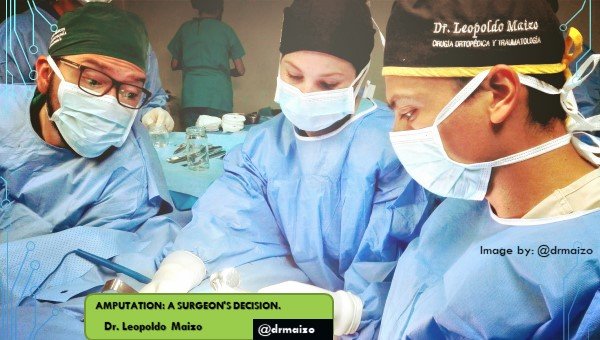

english
More than a surgery
Hello to all my dear Steemians, today before continuing with this post I must tell you that: The medical images you can see here are quite strong for the general public, as they are real cases that come to us every day in the emergency and we face each other. The identity of the patients is reserved, I recommend discretion.
Traumatic or accidental amputations are among the least desired surgeries for patients and surgeons in the area of orthopaedic and trauma surgery. It is always a difficult decision for the surgeon to perform this type of procedure, especially since the decision has to be made quickly in a stressful situation.
Probably the amputations that attract our attention are those that we observe at the level of the thigh, leg or arms, since they are the most striking and cause us great impact when we see them. It should be mentioned that this type of amputation is the one in which the patient is most at risk of losing his or her life. On the other hand, they are not the only ones that occur, we have amputations that go from the feet to the fingers (even from the tip of a finger).
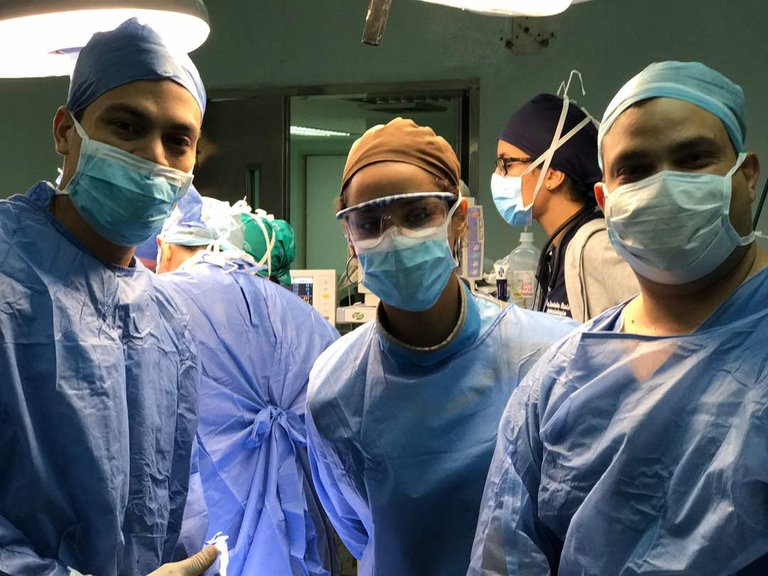
español
Más que una cirugía
Hola a todos mis queridos Steemians, el día de hoy antes de continuar con este post debo comentarles que: Las imágenes médicas que pueden ver aquí son bastante fuertes para el público en general, pues se tratan de casos reales que nos llegan a diario en la emergencia y al cual nos afrontamos. La identidad de los pacientes se reserva, recomiendo discreción.
Las amputaciones traumáticas o por accidentes son de las cirugías menos deseadas por los pacientes y los cirujanos en el área de la cirugía ortopédica y traumatología, representa siempre una decisión difícil para el cirujano realizar este tipo de procedimientos, sobre todo porque la decisión se tiene que realizar de manera rápida en una situación de mucho estrés.
Probablemente las amputaciones que nos llaman más la atención son aquellas que observamos a nivel del muslo, pierna o los brazos, ya que son las más llamativas y nos causan gran impacto al verlas, hay que mencionar que este tipo de amputaciones son en las que el paciente corre más riesgo de perder la vida. Por otro lado, no son las únicas que ocurren, tenemos amputaciones que van desde los pies hasta los dedos de la mano, (incluso de la punta de un dedo).


Medical Alert
Being on duty is a term that was applied since ancient times, in the time of the great wars represented being alert to the presence of the enemy, so no army was taken by surprise and could counterattack effectively.
Although more than a thousand years have passed since then, I must say that the doctors are still on duty, and although they are not enemies but rather actions for the benefit of anyone regardless of their creed, race or political affinity, it is a question of dealing with any medical emergency in an appropriate and timely manner in order to avoid complications that may even threaten their lives.
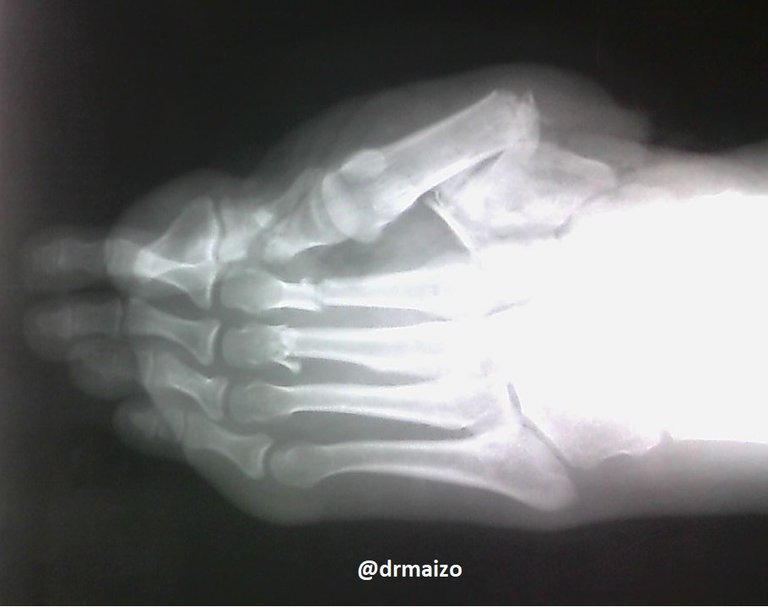
In this way, one of these nights, a medical guard where little sleep is provided warns us of the transfer of a patient who, after having lifted a heavy object (sewer cover), slips from his hands and falls heavily on his left foot, crushing his toe against the asphalt floor in a noisy way.
Alerta Médica
Estar de guardia es un término que se aplicaba desde los antiguos tiempos, en la época de las grandes guerras representaba estar alerta ante la presencia del enemigo, de esta forma ningún ejercito era tomado por desprevenido y podría contraatacar de manera efectiva.
Aunque ya han pasado más de mil años desde aquel entonces debo decir que aún se mantienen de guardia los médicos, y aunque no se traten de enemigos sino más bien de acciones en beneficio de cualquier persona indistintamente de su credo, raza o afinidad política, se trata de abordar de forma adecuada y a tiempo cualquier emergencia médica para evitar complicaciones que incluso atenten contra su vida.
De esta manera una noche de esas, una guardia medica donde poco se duerme nos avisan del traslado de un paciente que luego de haber levantado un objeto pesado (tapa de alcantarilla), se le resbala de sus manos y cae contundentemente sobre su pie izquierdo, aplastándole la punta del pie contra el suelo de asfalto de manera estrepitosa.

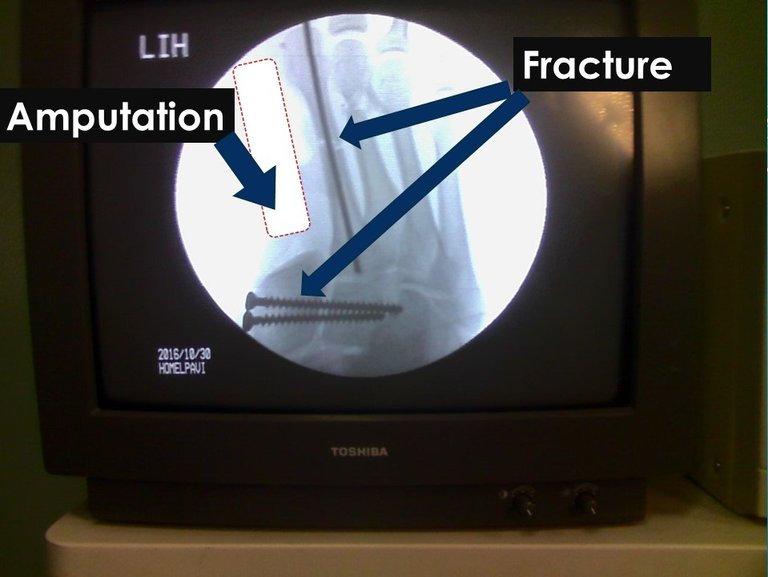
The moment
We went immediately to the emergency room once the patient arrived to ask about his condition, at that time the general doctors were distributed, one of them took his pulse and vital signs, while the other one interrogated the relatives about what had happened and our team evaluated the condition of his foot.
After the medical team confirmed that there was no damage to another part of his body, we quickly proceeded to evaluate the injuries to his left foot:
- There was a lot of bleeding.
- There was exposure of soft tissues (muscles, ligaments, and tendons) on the inside of the foot.
- There was an obvious deformity of the Hallux (big toe) from the root with a rather pale appearance.
In these cases the first thing we have to determine is the "viability of the affected limb or area", this means investigating if the injured area (the Hallux) has irrigation, because as we know the arteries are responsible for nourishing all the regions of the body, if there is a complete injury to these arteries would occur a death of all the tissue, so, even if we repair the ligaments, bones and muscles will not help without blood to keep it alive. The decision is final: Amputation of the Hallux toe and reconstruction of the other nearby areas of the foot.
Here I must open a parenthesis as an academic surgeon, because, although in our countries (Latin America), this type of injury is treated in this way because of the lack of support from medium-advanced technology, in other parts of the planet there is the well-known "microvascular repair", precisely for those cases where it is possible to repair these small arteries and thus avoid amputations. Of course, having this technology would, of course, reduce these drastic surgical decisions.
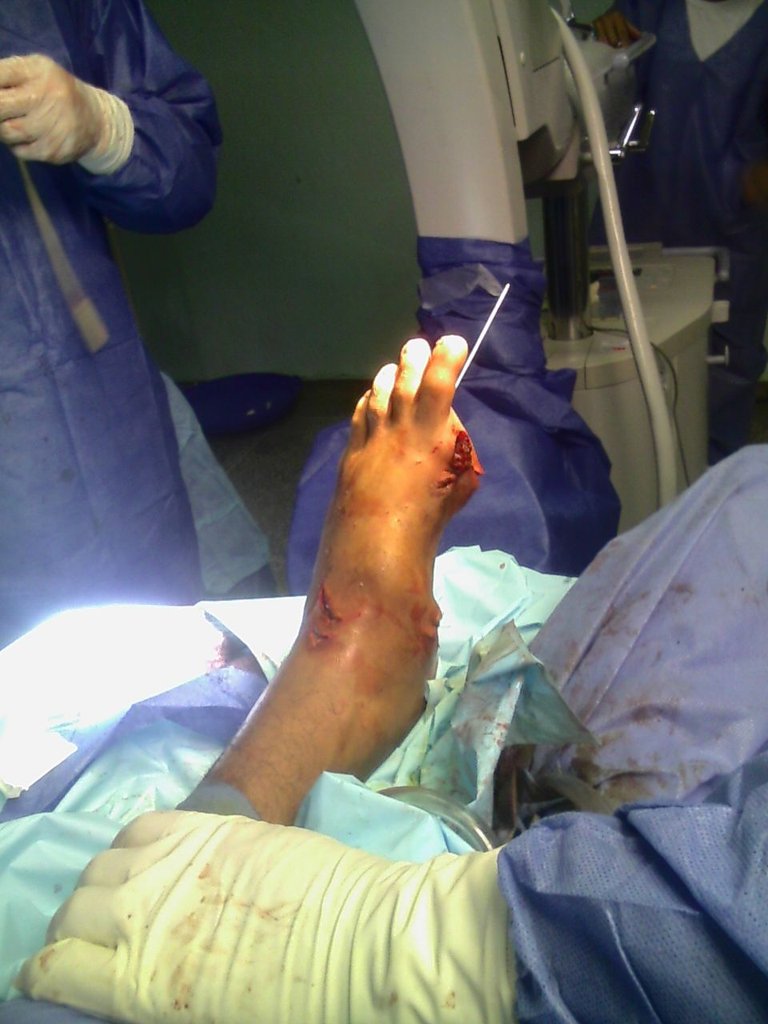
Finally, returning to the Venezuelan tropics, where we must inevitably act in this way, we return to a cold operating room.
When performing an amputation of any area it is important to consider several factors to avoid complications, first, it is necessary to determine the appropriate site for the amputation, which is usually determined by the surrounding skin lesions. If the skin of the area allows for the coverage of a kind of suitable'cap' we are working in an appropriate place.
After this, eliminate all those tissues that could become infected because of the lack of blood or because the crushing itself would mistreat them, since if one leaves these tissues they could necrotic (die), bringing as a consequence severe infections.
Finally, to properly reconstruct the elements such as arteries, veins, nerves, muscles, tendons and muscles, this is a very meticulous job because if something goes wrong it will cause complications in the future.
In our case it was not only necessary to repair the areas near the Hallux but also a fracture associated with the second metatarsal that we were able to stabilize with a surgical wire.
The lesions will probably show up a little stronger after the amputation, but over time it will heal properly and your bones will join together. As for the Hallux, it is important to mention that the displacement will be affected, but external devices or prostheses have been designed that adapt adequately to supplant the functions in a satisfactory way.
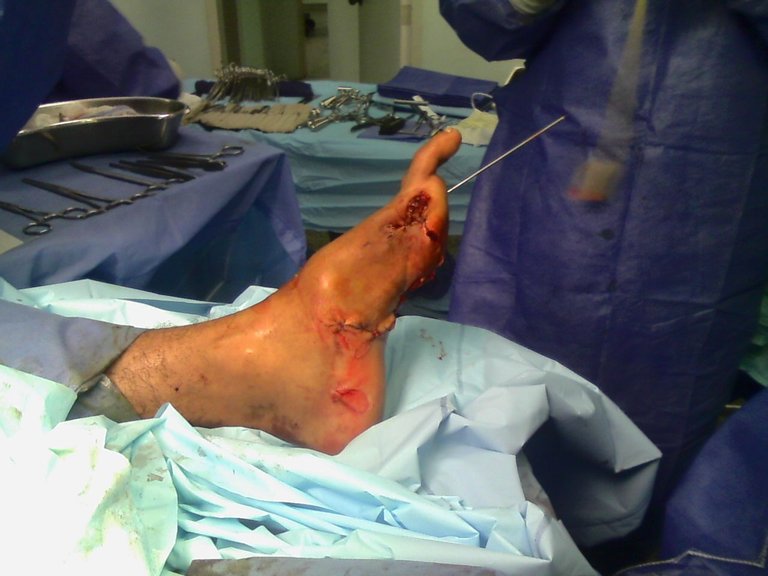
It is always a hard experience and at the same time a learning experience in this type of situation, it fills us with confidence for the coming emergencies in an upcoming "Medical Guard".
El momento
Acudimos de forma inmediata a la sala de emergencias una vez llegó el paciente para preguntar sobre su estado, en ese momento los médicos generales estaban distribuidos, uno le tomaba el pulso y los signos vitales, al mismo tiempo que otro interrogaba a los familiares sobre lo sucedido y nuestro equipo evaluaba el estado de afectación de su pie.
Luego de que el equipo médico confirmara que no hubo daño en otra parte de su organismo procedimos rápidamente a evaluar las lesiones de su pie izquierdo:
- Se apreciaba abundante sangrada.
- Había exposición de tejidos blandos (músculos, ligamentos y tendones) del lado interno del pie.
- Se apreciaba una evidente deformidad del Hallux (dedo gordo del pie) desde su raíz con aspecto bastante pálido.
En estos casos lo primero que tenemos que determinar es la “viabilidad del miembro o zona afectada”, esto significa indagar si esa zona lesionada (el Hallux) presenta irrigación, pues como sabemos las arterias son las encargadas de nutrir todas las regiones del cuerpo, de haber una lesión completa de estas arterias ocurriría una muerte de todo el tejido, así que, aunque reparemos los ligamentos, huesos y músculos no servirá de nada sin sangre que lo mantenga vivo. La decisión es definitiva: Amputación del dedo Hallux y reconstrucción de las demás zonas cercanas del pie.
Aquí debo abrir un paréntesis como cirujano académico que soy, pues, aunque en los nuestros países (Latinoamérica) se trate así este tipo de lesiones en vista de no contar con apoyo de aparatos con tecnología medianamente avanzada, en otros lugares del planeta existe la conocida “reparación microvascular”, precisamente para estos casos en donde se pueda reparar estas pequeñas arterias y así evitar amputaciones. Por supuesto, de alguna vez contar con esta tecnología se disminuirían estas decisiones quirúrgicas tan drásticas.
En fin, volviendo al trópico venezolano donde irremediablemente tenemos que actuar de esta forma volvemos a una sala fría de quirófano.
Cuando se realiza una amputación de cualquier zona es importante tener en cuenta varios factores para evitar complicaciones, en primer lugar, es necesario determinar el lugar apropiado para la amputación, que generalmente viene determinado por las lesiones de piel alrededor. Si la piel de la zona permite la cobertura de una especie de “capuchón” adecuado estamos trabajando en un lugar apropiado.
Luego de esto eliminar todos aquellos tejidos que pudiesen infectarse por no llegarle sangre o porque el mismo aplastamiento los maltrato, ya que si uno deja estos tejidos pueden necrosarse (morir), trayendo como consecuencia infecciones severas.
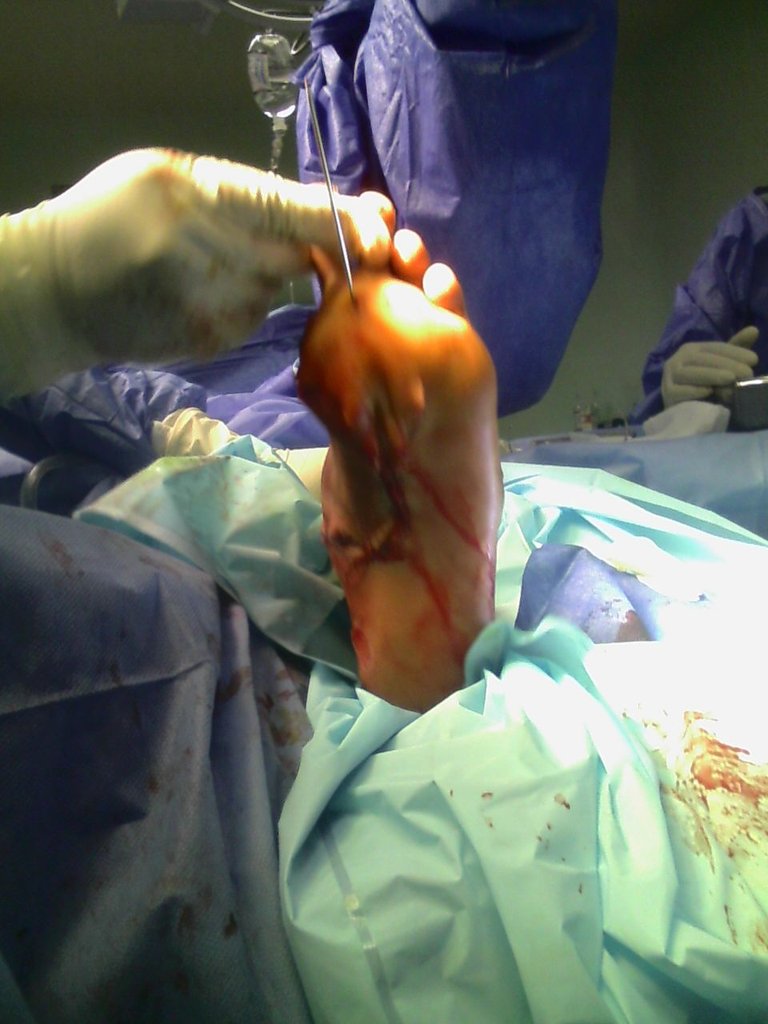
Por último, reconstruir adecuadamente los elementos como arterias, venas, nervios, músculos, tendones y músculos, esto es un trabajo muy meticuloso ya que de salir algo mal originaría complicaciones a futuro.
En nuestro caso hubo no solo que reparar las zonas cercanas al Hallux sino una fractura asociada al segundo metatarsiano que logramos estabilizar con un alambre quirúrgico.
Probablemente las lesiones se aprecien un poco fuertes luego de la amputación, pero con el tiempo ira cicatrizando de manera apropiada y sus huesos se unirán. En cuanto al Hallux, es importante mencionar que el desplazamiento se vera afectado, pero se han diseñado dispositivos o prótesis externas que se adaptan adecuadamente para suplantar las funciones de forma satisfactoria.
Siempre es una experiencia dura y al mismo tiempo de aprendizaje este tipo de situaciones, nos llena de confianza para las venideras emergencias en una próxima “Guardia Médica”.

We are doing everything possible to help many people in need of surgery, through our company Sermedic we eliminate the high costs by accepting cryptocurrencies for patients who need our help at the best price in the world and without intermediaries. You can read more about our project in:
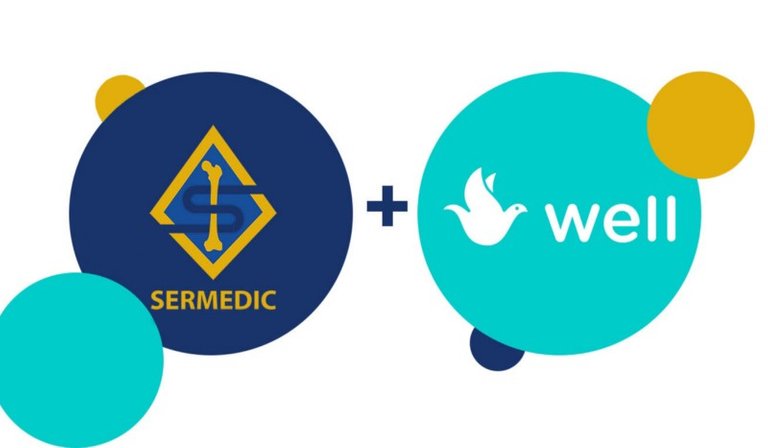
Read more in: Source
If you liked this post and you are interested in clinical cases do not hesitate to follow me. I will be publishing many more cases soon.
Text📑 and Photos 📷 by: @drmaizo
Estamos haciendo lo posible por ayudar a mucha gente necesitada por cirugías, a través de nuestra empresa Sermedic eliminamos los altos costos aceptando criptomonedas para pacientes que necesiten nuestra ayuda al mejor precio del mundo y sin intermediarios. Puedes leer más acerca de nuestro proyecto en:

Lee más en: Fuente.
Si te gustó este post y te interesan los casos clínicos no dudes de seguirme. Estaré publicando pronto muchos más casos.
Relato📑 y Fotos 📷 por: @drmaizo
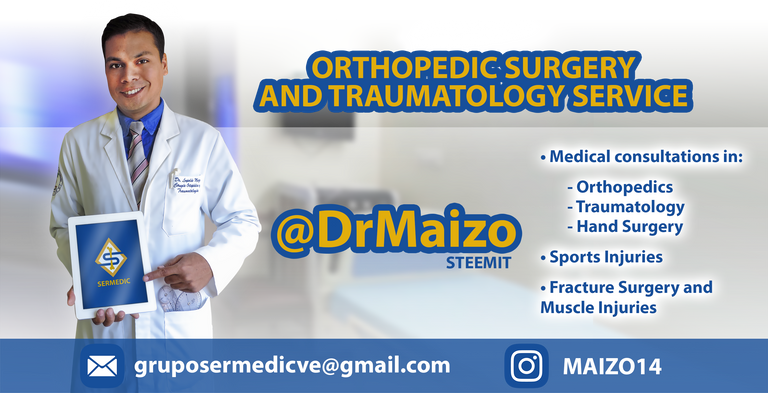




 }
}
.png)
Congratulations! This post has been upvoted from the communal account, @minnowsupport, by drmaizo from the Minnow Support Project. It's a witness project run by aggroed, ausbitbank, teamsteem, theprophet0, someguy123, neoxian, followbtcnews, and netuoso. The goal is to help Steemit grow by supporting Minnows. Please find us at the Peace, Abundance, and Liberty Network (PALnet) Discord Channel. It's a completely public and open space to all members of the Steemit community who voluntarily choose to be there.
If you would like to delegate to the Minnow Support Project you can do so by clicking on the following links: 50SP, 100SP, 250SP, 500SP, 1000SP, 5000SP.
Be sure to leave at least 50SP undelegated on your account.
hola @drmaizo quisimos contactarlo desde el equipo de TrulyFakeNews en español, quisieramos su opinion medica sobre nuestro mas reciente articulo, esperamos que pueda explicarle al mundo que esto si es posible y nuestra teoria tiene sentido.
Saludos doc.
https://steemit.com/introduceyourself/@trulyfakenews/truly-fake-news-02-hugo-chavez-no-murio-solo-cambio-de-sexo-otros-presidentes-haran-lo-mismo-y-asi-luciran
Hola @trulyfakenews, seguro que me paso pronto por tu blog, suena interesante. Gran abrazo.
excelente exposicion. quisiera compartir contigo mi experiencia y opiniones en muchos temas que nos son comunes. Felicidades.
Gracias @frank188, seguro que sí. Puedes ver mi trabajo también en las redes sociales. Un abrazo amigo.
Beautiful Qurite :)
Thanks buddy :D @globetrottergcc
Hola! excelente caso colega, gracias por compartir!
Gracias Gabi, a tí por comentar. :D